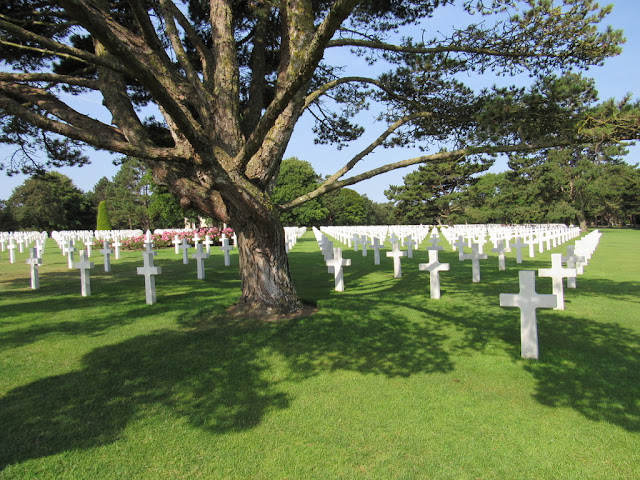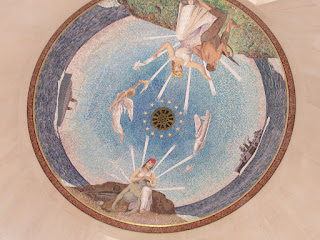Eternity is their mission now. These brave men, many of them 18, 19, 20 years old, took part in the greatest air, land, and sea invasion in history--and gave their lives for freedom. But the guns are silent now in this place of peace as they rest in the stillness of a green plateau overlooking the sea. One cannot help but be inspired by them and their bravery. May they rest in peace.
On June 6, 1944, 160,000 American, British, and Canadian soldiers landed here out of planes and off ships at low tide along 50 miles of coastline. There was so much debris left on the beaches that it took 10 years to clear it. French prisoners were put to work as part of their sentence.
With the Normandy Beach landings, the Allies established a beachhead that would prove to be a turning point in the war. Despite
losing more than 9,000 Allied forces on D-Day, the invasions opened up a
path for 100,000 Allied troops to march across Europe and push back the
Germans as they went. Less than a year later, the
Germans surrendered, and the Western Front of World War II came to an
end on May 8, 1945.

"It serves as a significant tribute to the courage of the Allied Forces soldiers who sacrificed their lives for the liberty of our peoples and as a reminder to coming generations that those who died did so in defense of our shared values of tolerance and freedom. The spirit of those who sacrificed so much will rise through the waters and linger in our collective memories thanks to your sculpture." US Ambassador Howard H. Leach on the 60th anniversary of the Normandy landing--2004.
 The inscription on the monument reads: "The Allied Forces landing on this shore which they call Omaha Beach liberate Europe -- June 6, 1944."
The inscription on the monument reads: "The Allied Forces landing on this shore which they call Omaha Beach liberate Europe -- June 6, 1944."
 The inscription on the monument reads: "The Allied Forces landing on this shore which they call Omaha Beach liberate Europe -- June 6, 1944."
The inscription on the monument reads: "The Allied Forces landing on this shore which they call Omaha Beach liberate Europe -- June 6, 1944." Pont du Hoc was the highest land between
Omaha and Utah beaches. Six German artillery guns had been positioned there and four bunkers were being constructed. US Army Rangers struggled to scale these 100-foot cliffs at
6:40am on June 6 to take out the artillery, and they succeeded. However, the Germans had already moved.
Pont du Hoc was the highest land between
Omaha and Utah beaches. Six German artillery guns had been positioned there and four bunkers were being constructed. US Army Rangers struggled to scale these 100-foot cliffs at
6:40am on June 6 to take out the artillery, and they succeeded. However, the Germans had already moved.The entire clifftop is pock-marked with bomb craters and huge batteries. The scene has been left as it was and is an official
war grave for the men who still lie beneath the ruins.
The first American cemetery is on a cliff overlooking the Normandy beaches a few miles away from Omaha Beach. The soldiers of the 607th Quartermaster Graves Registration Unit had difficulty gathering the dead while under enemy fire. Consequently, they created this communal grave site in the "Easy Red sector" (le Ruquet) and buried 457 soldiers here on June 7. By June 10, 1,450 men had been buried. High commanders of the US Army, including General Eisenhower and General Marshall, took part in formalities honoring the dead on June 12, and a Mass for the dead was held here on June 25. In July, some of the bodies were moved to the current American Cemetery at Colleville-sur-Mer. Below are some original photos taken of these ceremonies, which are posted at this gravesite.


American Cemetery at Colleville-sur-Mer
The cemetery spreads over 172.5 acres and has 9,380 graves. It is one of two American cemeteries in Normandy. The French gave the Americans the land after the war, and the cemetery is administered by an American officer who employs 17 French gardeners. Five million people come here every year and school children are among the visitors.
France has a great feeling of gratitude for the D-Day "liberation", as the French call it, especially in Normandy, said Chantal, the guide on our tour.
The cemetery overlooks the ocean that the fallen had crossed to establish a beachhead in order to liberate Europe from the Nazis.
The Memorial is in the background of the central mall as red pathways, green lawns, and the reflecting pond frame it. There are just as many graves in front of the Memorial as there are behind it.

The Spirit of American Youth Rising from the Waves is a 22 foot-high bronze statue and a stark reminder of the youth of the Fallen. Their average age was 24. Behind the memorial is the Wall of the Missing, which lists the names of 1,557 men who had been
lost.
The Chapel at the other end of the Mall covers an altar which says: "I give unto them eternal life and they shall never perish."

The colorful Mosaic ceiling symbolizes the United States, which blesses its sons fighting for freedom and a grateful France, which lays a laurel wreath among the Americans who gave their lives for the liberation of Europe.

 A Jewish soldier's marker has stones and a pine cone on it as part of the Jewish tradition for honoring the dead.
A Jewish soldier's marker has stones and a pine cone on it as part of the Jewish tradition for honoring the dead.
The
graves of Quentin Roosevelt and Theodore Roosevelt, Jr. are together in
the cemetery. They are the sons of President Theodore Roosevelt.
Quentin, a pursuit pilot during World War I was killed in aerial combat over France on July 14, 1918. Theodore was a brigadier general in World War II who died on July 12, 1944 at age 56. He received
the Medal of Honor posthumously for his role at Utah Beach.
Here is the citation:
For gallantry and intrepidity at the risk of his life above and beyond the call of duty on 6 June 1944, in France. After two verbal requests to accompany the leading assault elements in the Normandy invasion had been denied, Brig. Gen. Roosevelt's written request for this mission was approved and he landed with the first wave of the forces assaulting the enemy-held beaches. He repeatedly led groups from the beach, over the seawall, and established them inland. His valor, courage, and presence in the very front of the attack and his complete unconcern at being under heavy fire inspired the troops to heights of enthusiasm and self-sacrifice. Although the enemy had the beach under constant direct fire, Brig. Gen. Roosevelt moved from one locality to another, rallying men around him, directed, and personally led them against the enemy. Under his seasoned, precise, calm, and unfaltering leadership, assault troops reduced beach strong points and rapidly moved inland with minimum casualties. He thus contributed substantially to the successful establishment of the beachhead in France.
These men worked quietly and respectfully among the grave sites. The individual grave stones are cleaned regularly--every single marker.
German Cemetery at La Cambe

A few miles down the road from the Normandy Beaches is the German cemetery at La Cambe. It is more muted in presentation, but it also shows respect for the dead as barely visible black crosses dot the grounds. The small, 16.5- acre cemetery has 21,222 soldiers. The graves packed closer and each small marker set in the ground has two soldiers buried underneath. These photos were taken in a moving bus. For a view of the cemetery by MechTraveller, click here.
Resources
Earth, The Science Behind the Headlines
Planetware
Normandy Tourism























No comments:
Post a Comment